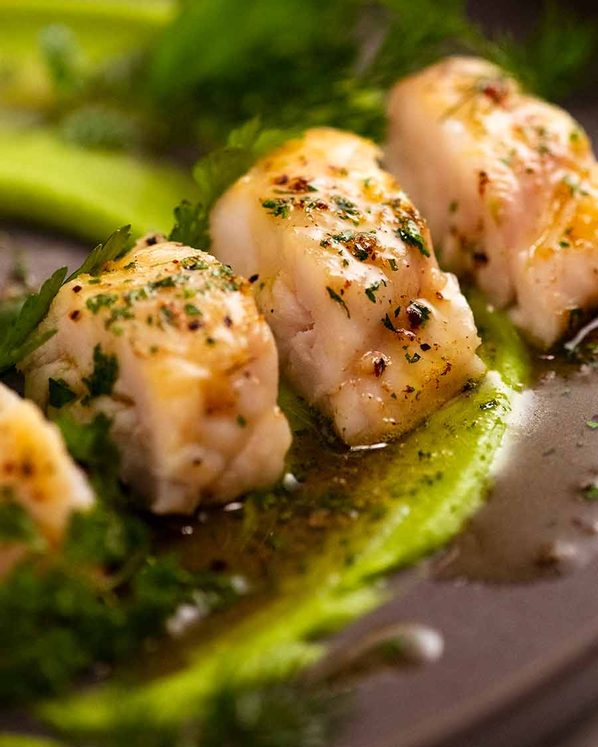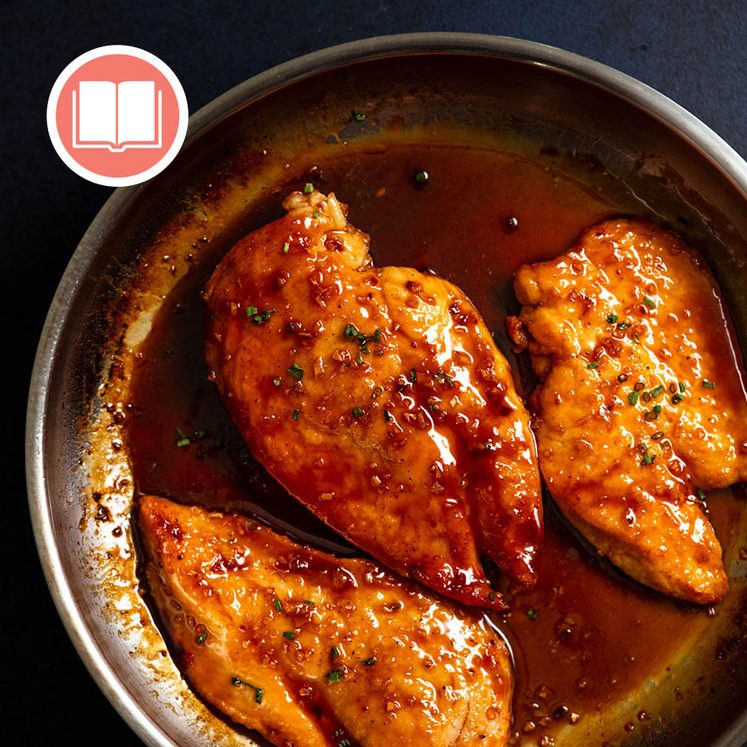With sweet and meaty lobster-like flesh, Monkfish is affectionately known as “poor man’s lobster”. But there’s certainly nothing “poor” about this dish! If you’re new to cooking Monkfish, this is a good recipe to try because it’s easy and showcases just how good monkfish is. There’s a reason monkfish is a firm favourite with fine dining restaurants!
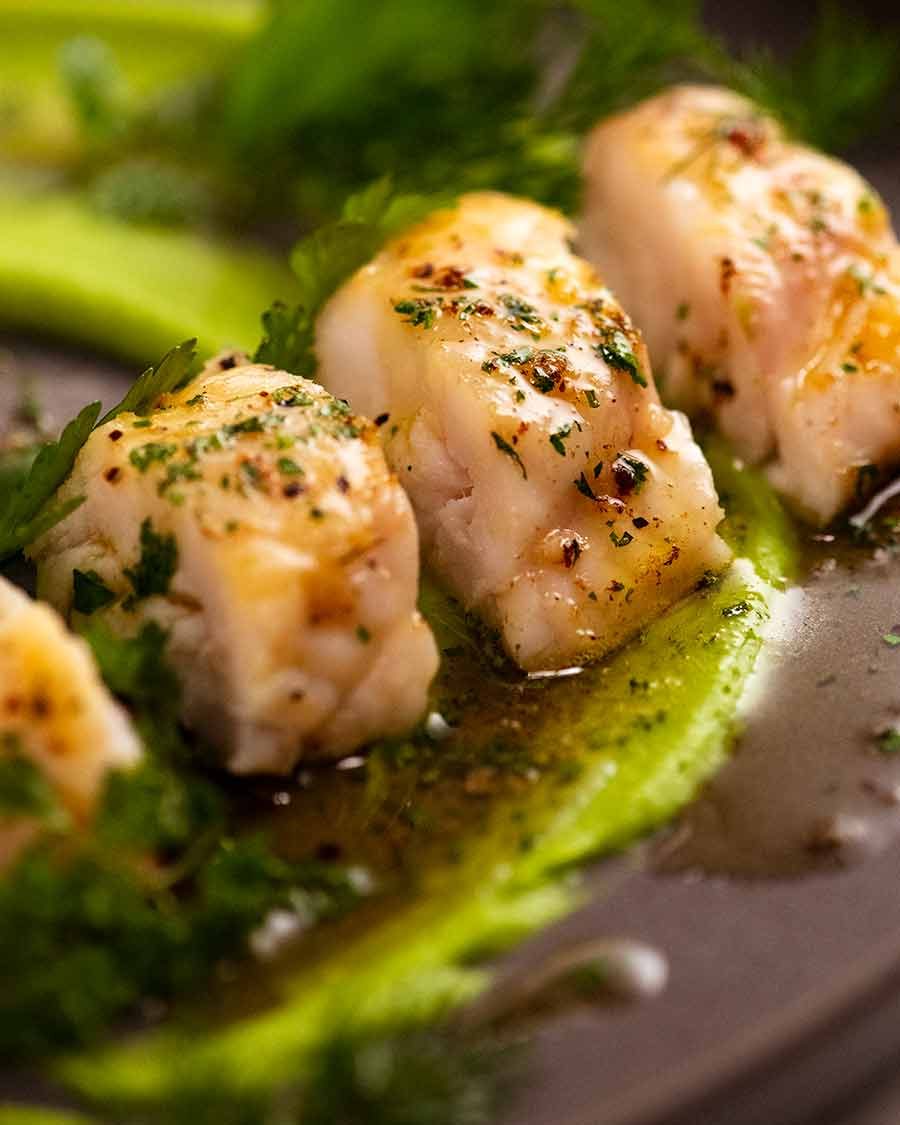
Monkfish recipe
Monkfish, also known as Stargazer in Australia, is affectionately known as “poor man’s lobster” because the flesh resembles lobster meat – only much more economical. The cooked meat of a monkfish has a similarly meaty and succulent texture, with a sweet and clean flavour that’s not fishy at all. Monkfish fillets are also thick and hefty like lobster tails.
With this in mind, this recipe for monkfish is based on a way I like to prepare lobster tails: pan-seared with a Herb Brown Butter Sauce. It’s a simple but classic sauce that works with any seafoods. Brown butter has a more intensely nutty flavour than just plain melted butter that makes this just that little bit more interesting.
It’s quick and easy enough for a nice midweek meal, taking 15 minutes (tops) from start to finish. I’m also sharing an attractive way of presenting the fish that I think makes this Monkfish recipe worthy of a place on the menus of upmarket restaurants!

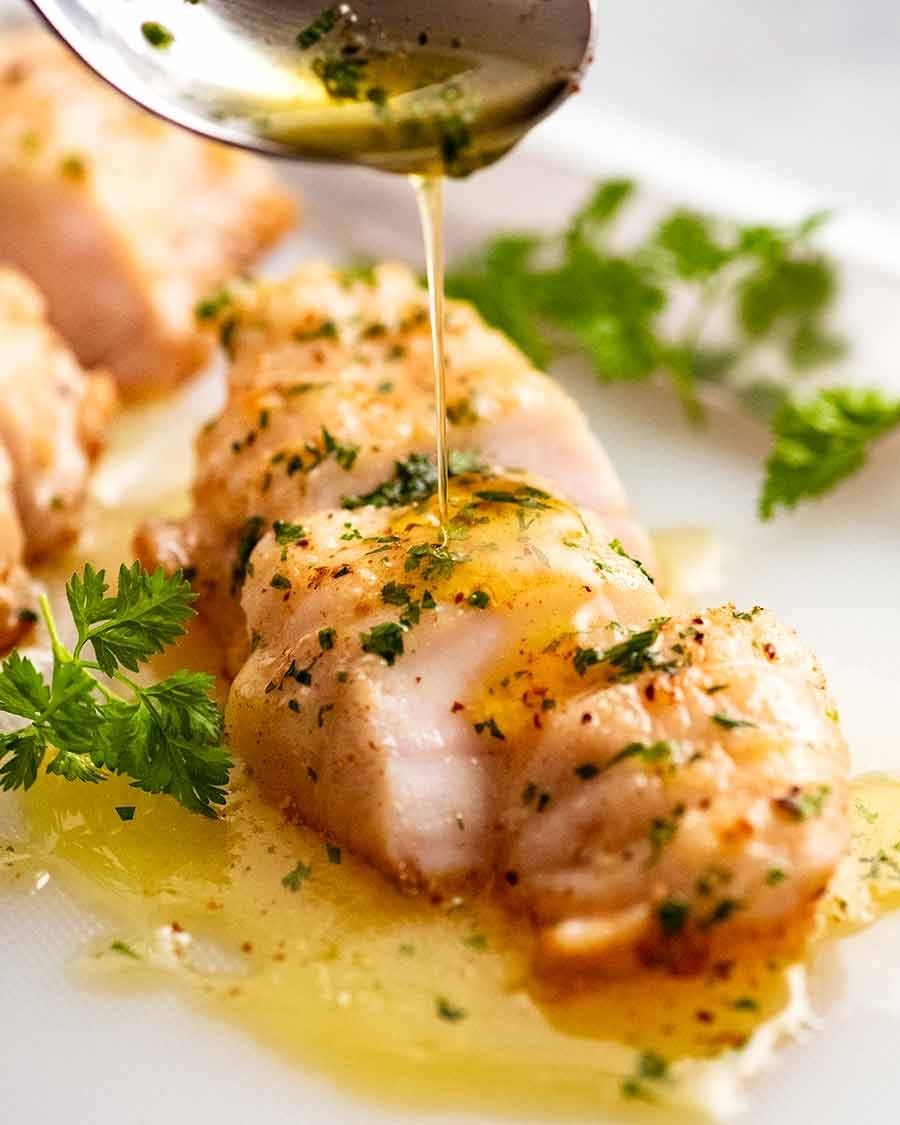
Monkfish recipe ingredients
Here’s what you need to make this monkfish recipe. While I’ve made this using monkfish, it can be made with any fish suitable for pan-searing. Also, see here for the Salmon version of this recipe.
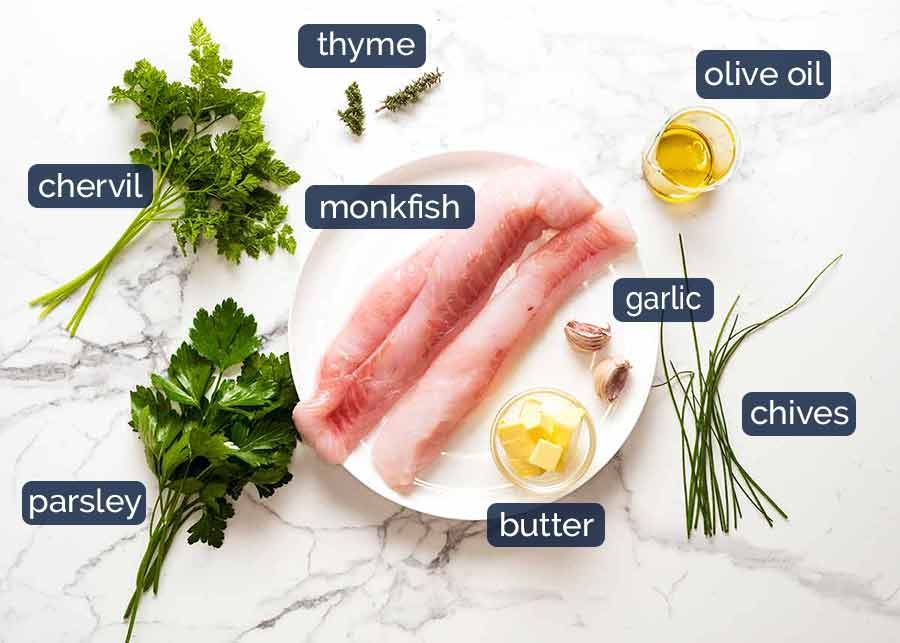
Monkfish (also known as “Stargazer” in Australia)
Monkfish is a deep sea fish widely available at fishmongers in Sydney (usually imported from New Zealand), sometimes labelled “Stargazer”. The fish has tough skin and a giant head with a face only a mother could love. This explains why it’s always sold as skin-off fillets here! As they say though, it’s what’s on the inside that counts: The flesh is truly delicious and monkfish is a highly prized table fish around the world.
You may have in the past overlooked monkfish because it’s not a fish familiar to you. Well, no more! 🙂 Aside from the appealing lobster-like qualities of the flesh, it’s a clean-tasting fish that’s good for people who are sensitive to or dislike “fishy”-tasting fish.
It’s also a fish that’s excellent to “do fancy” with, because it’s easy to present attractively. The fillets are thick, cylindrical and long in shape, almost like pork tenderloins, making them simple to slice into neat chunks and arrange artfully on a plate. (My attempt at plating up nicely is shown at the bottom of the post!)
The larger of the monkfish fillets pictured above and below is actually not that big, around 200g (7oz) per whole fillet. The smaller one is about 100g (3.5oz), giving 1 1/2 fillets total or about 300g (10oz). For 2 people that’s 150 – 180g (5 – 6oz) of fish per person, which is a standard serving size.
It’s best to cut them into large(-ish) pieces for pan-searing as it will help them cook through more evenly, as well as making them easier to handle in the pan. The photo below shows where I cut them.
How to cut monkfish fillets for pan-searing
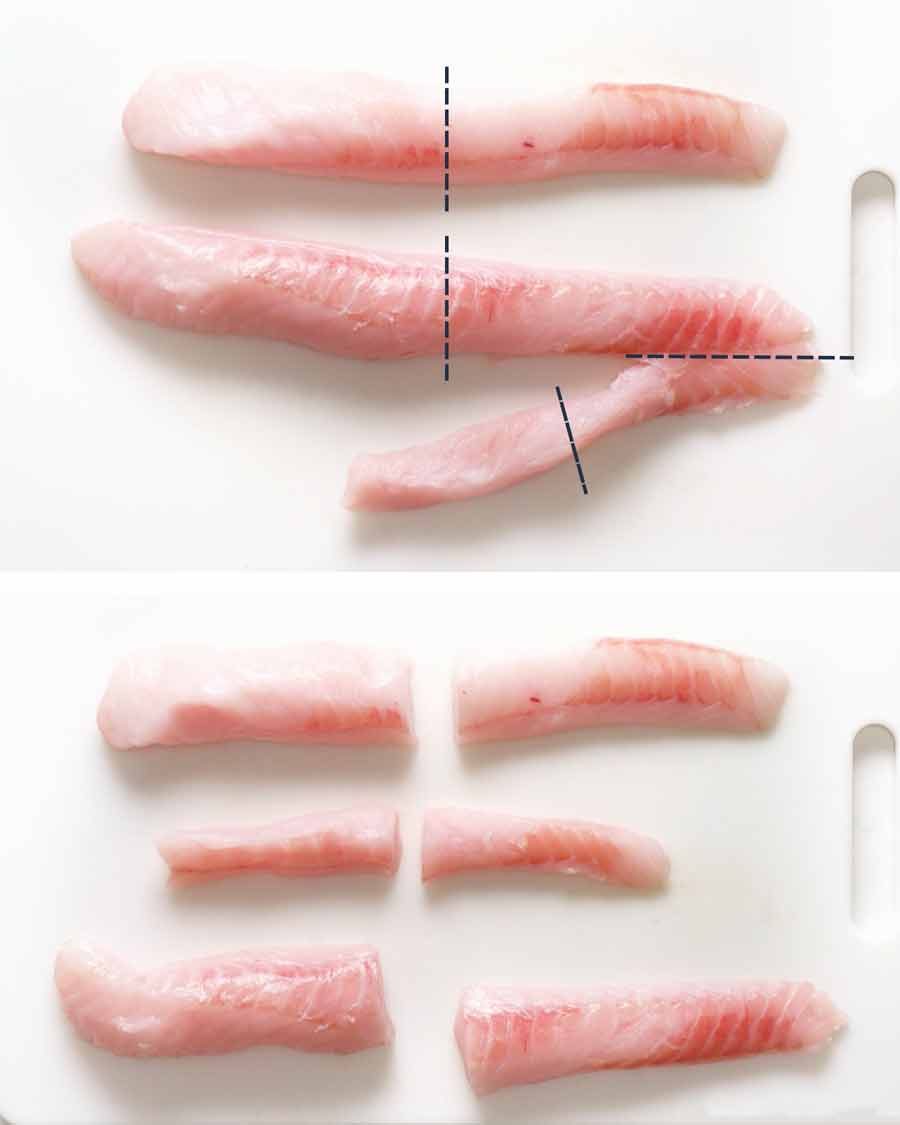
Other ingredients required
-
Olive oil – This is used to pan-fry the fish. Oil is used for the cooking of the fish, while butter is only used for finishing because it burns easily (unless you use copious amounts or very low heat, neither of which suit this recipe);
-
Butter – The sauce for this fish recipe is a brown butter sauce. It’s made simply by leaving melted butter in the pan long enough to cook so the taste becomes nutty. Despite the name it turns more a golden colour. Suitable, given that brown butter is also referred to as liquid gold – it’s that good!
In this particular recipe, we’re spooning the hot butter over the fish as it cooks to add flavour and help finish the fish.
-
Garlic and thyme – These herbs flavour the butter that’s spooned over the fish. We keep them whole and fish them out at the end so we get the flavour in the butter without any burnt bits left in the sauce;
-
Fresh herbs – Not essential but fresh herbs are lovely for visuals and a fresh element. I’ve used an elegant combination of parsley, chervil and chives. Partly because I’m lucky enough to have these thriving in my herb garden at the moment and they make a lovely combination!
You could use just one of these herbs or even skip herbs altogether. Brown butter without herbs is the basic burnt butter sauce called beurre noisette in French. Here’s my recipe (an excellent staple sauce for fish, but also over ravioli, chicken, omelettes, and other dishes!)
How to cook Monkfish
Basting with garlic-thyme infused butter as the monkfish cooks is the little restaurant trick that transforms this otherwise very simple dish into something a little more special! Just think of all the good things that happen as the butter seeps into the cracks and crevices of the monkfish …
This is a simple technique you see pro chefs do in restaurant kitchens to both flavour and help finish cooking fish. It’s easy even for novice cooks and you’ll feel like a total pro doing it!
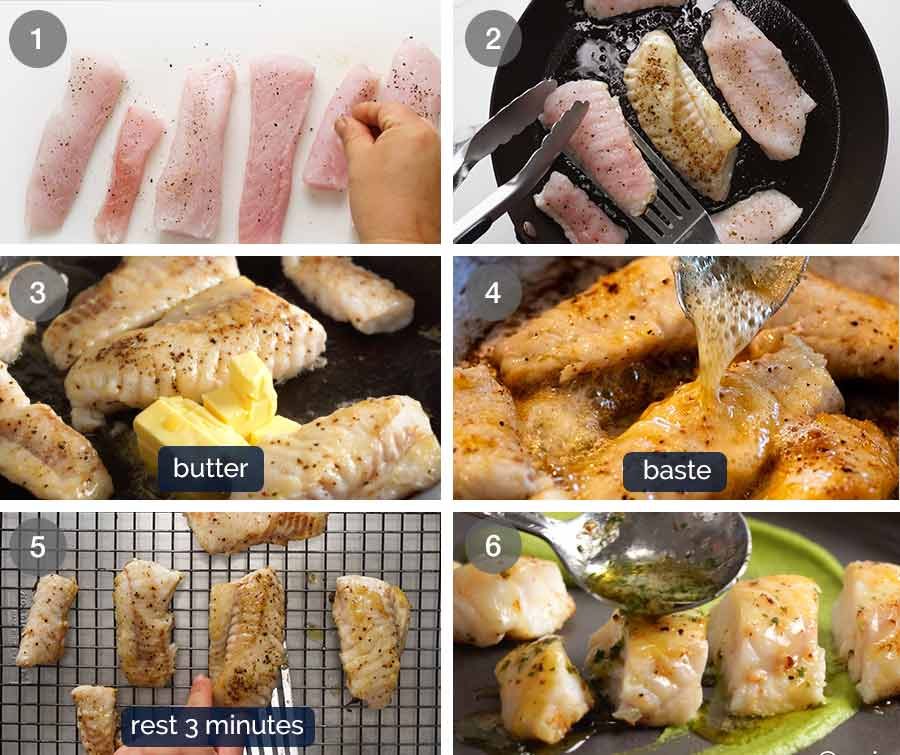
-
Cut and season: Cut the monkfish fillets into roughly equal size pieces so they cook in the same time. The number of pieces will depend on the size of the fillets you get and how they are cut. See photo above for how I cut the fillets I had.
Sprinkle the monkfish fillets with salt and pepper on both sides. You won’t need to oil the flesh prior, it will stick to the flesh;
-
Pan sear: Heat oil in a large non-stick pan over medium-high heat (or medium heat if your stove is strong). Place the thickest pieces of fish into the pan first. Leave for 1 minute then add the thinner (tail end) pieces. Cook for a further 2 minutes, then flip all pieces;
-
Melt butter: As soon as you turn the fish, add the butter. When it starts melting, add garlic and thyme;
-
Baste, baste, baste! When the butter has fully melted and starts foaming, tilt the pan and start spooning the butter over the fish. The butter imparts flavour to the surface of the fish and gives it an extra-rich taste. Bathing with the hot butter also speeds up and promotes even cooking of the fish.
Baste the monkfish for 2 minutes or or until the internal temperature is 55°C/131°F. This gives a medium doneness where there is no rare or raw flesh and the fish is at optimum juiciness. The butter will begin to smell nutty – brown butter!
If you don’t have a meat thermometer, test if the flesh flakes easily at the thickest point to see if it’s done;
-
Rest: Transfer fish on to a rack and rest for 3 minutes.
-
Herbs: Stir herbs into the butter left in the pan. Spoon the butter over plated monkfish to serve. See below for plating up suggestion.
This recipe makes a little over one tablespoon of Herb Brown Butter per serving. It doesn’t sound like much, but it’s all you need. Brown butter is super-rich! It’s not only 100% butter but also has a richer flavour than plain melted butter.

-

Plating up monkfish – fine dining style! -
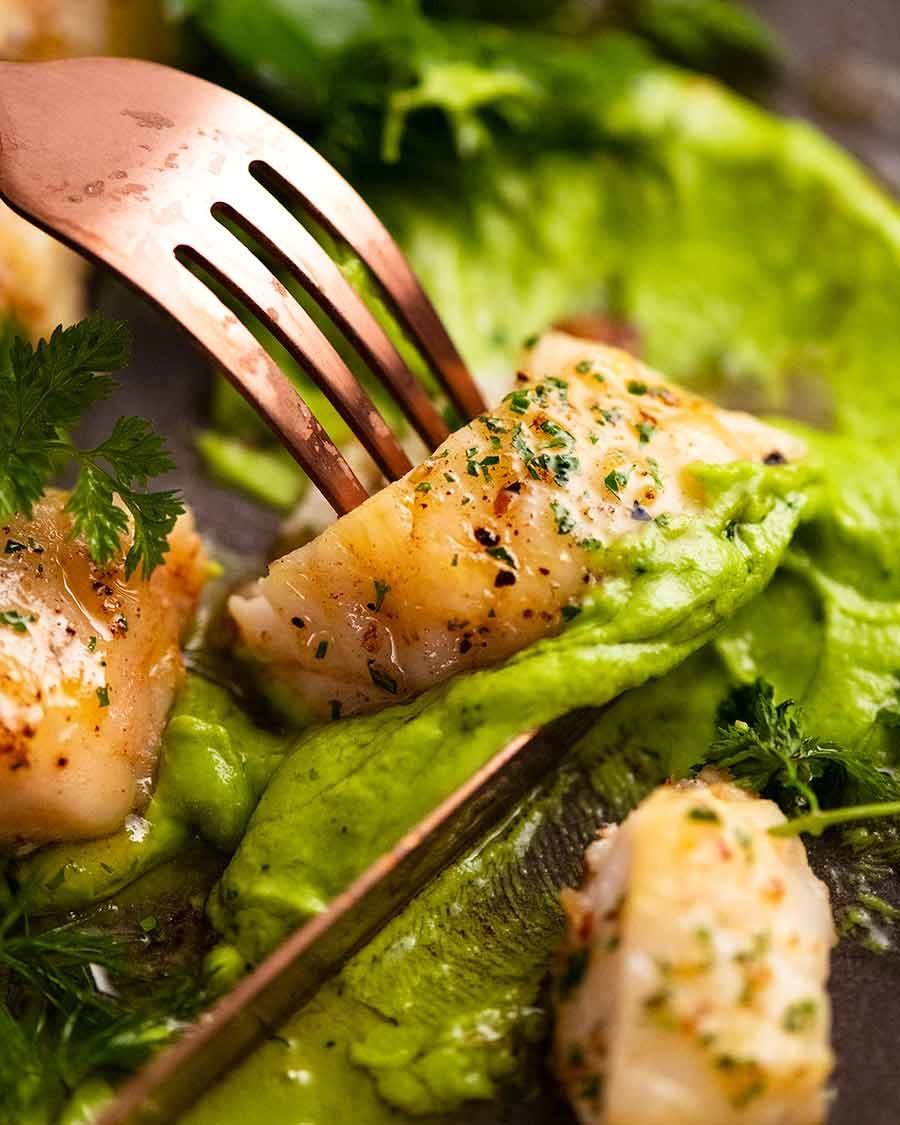
Pea puree acts like a second sauce – so good!
Monkfish plating up suggestion – fine dining style!
One of the unique things about monkfish is that the fillets are so thick and meaty they can be sliced like a steak. You see restaurants taking full advantage of this to present monkfish in all sorts of creative, beautiful ways.
Above is my effort to plate up Monkfish, fine-dining style! Dark coloured plate, vibrant green pea puree and white Monkfish looks beautiful (I think, anyway!) Here’s how to replicate this:
-
After resting, slice monkfish into 2.5cm / 1″ pieces. Hold the fish carefully with your fingers and use a sharp knife so you can cut neat slices;
-
Smear a big dollop of pea puree on a plate and arrange monkfish pieces on puree (as pictured, or come up with your own way!); and
-
Drizzle with Herb Brown Butter from the pan. Optional garnish: any combination of dill, parsley, chervil.
Other side suggestions for Monkfish
-
Choose a side salad using your favourite vegetables (leafy green salads go especially well, I think);
-
Mini Potato Dauphinoise stacks, a Crispy Potato Rosti or virtually any potato side; or
-
For something different, try this (simple and baked!) Lemon Herb Risotto or any rice side or rice salad (non-Asian, I’d suggest).
So many possibilities! – Nagi x
Watch how to make it
Hungry for more? Subscribe to my newsletter and follow along on Facebook, Pinterest and Instagram for all of the latest updates.
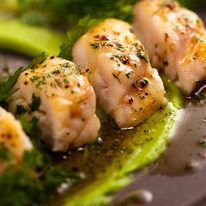
“Poor Man’s Lobster” – Monkfish with Herb Browned Butter
#wprm-recipe-rating-0 .wprm-rating-star.wprm-rating-star-full svg * { fill: #343434; }#wprm-recipe-rating-0 .wprm-rating-star.wprm-rating-star-33 svg * { fill: url(#wprm-recipe-rating-0-33); }#wprm-recipe-rating-0 .wprm-rating-star.wprm-rating-star-50 svg * { fill: url(#wprm-recipe-rating-0-50); }#wprm-recipe-rating-0 .wprm-rating-star.wprm-rating-star-66 svg * { fill: url(#wprm-recipe-rating-0-66); }linearGradient#wprm-recipe-rating-0-33 stop { stop-color: #343434; }linearGradient#wprm-recipe-rating-0-50 stop { stop-color: #343434; }linearGradient#wprm-recipe-rating-0-66 stop { stop-color: #343434; }
Ingredients
- 300g / 10ozmonkfish fillets, skinless and boneless (Note 1)
- 1 1/2tbspextra virgin olive oil
- 1/4tspsalt
- 1/8tspblack pepper, finely ground
- 2 tbsp/ 30gunsalted butter, cut into 1cm (1/2″) cubes
- 2garlic cloves, smashed (Note 2)
- 2sprigs thyme
Fresh herbs (Note 3):
- 1/2tspparsley, finely chopped
- 1/2tspchives, finely chopped
- 1/2tspchervil, finely chopped
Instructions
-
Cut fillets: Cut each monkfish into 3 or 4 even size pieces. (Note 1)
-
Season: Sprinkle both sides of fish with salt and pepper.
-
Rack for resting: Place a rack over a tray (optional, for resting fish, Note 5)
Cooking monkfish (Note 2):
-
Heat oil: Heat oil in non-stick pan over medium heat (medium-high for weak stoves).
-
Sear first side, then turn: Place thickest pieces of fish in the pan first. Leave for 1 minute then add the thinner pieces. (Note 4). Cook for a further 2 minutes, then flip fish.
-
Add butter and baste: Add butter to pan. After it starts melting, add garlic and thyme. When the butter starts foaming, tilt the pan and start spooning the butter over the fish. Do this for 2 minutes or until the internal temperature is 55°C/131°F (Note 6), or the flesh flakes easily. Butter will begin to smell nutty – it’s now brown butter!
-
Rest: Transfer fish onto the rack and rest for 3 minutes.
-
Add herbs: Add herbs to butter remaining in pan. Serve this Herb Brown Butter with monkfish.
Optional plating up, fine dining style!
-
Slice monkfish into 2.5cm / 1″ pieces. Place on pea puree, then drizzle with Herb Brown Butter. Optional garnish with any combination of dill, parsley, chervil.
Recipe Notes:
Nutrition Information:
Life of Dozer
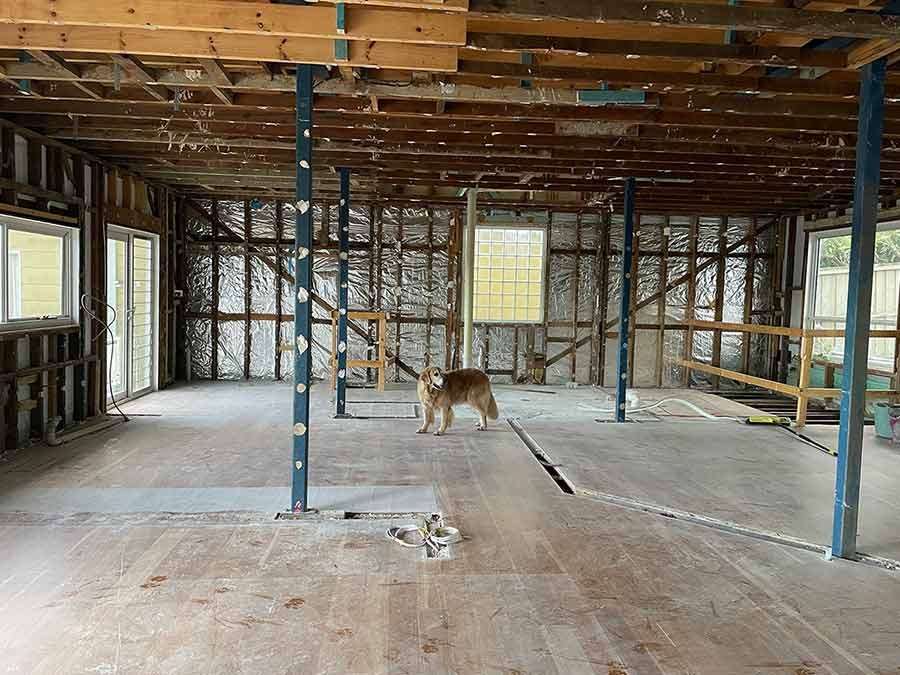
Demolition done, walls are out! The house renovation is well and truly underway – and Dozer is thoroughly confused. This used to be home…..? What happened to his favourite room, the pantry?? (It used to be pretty much where he is standing!)
For those playing catch up, I’m renovating my house to build my dream kitchen. It turns out, this whole renovation thing is a little more involved than I expected it to be. 🙀 I thought I could live downstairs in the spare room, using the work kitchen. It turns out, it’s not really viable. Something about needing running water and electricity, and not living with jackhammering from 8am every morning. So I’ve moved out temporarily, renting a nearby house! Photos soon!
